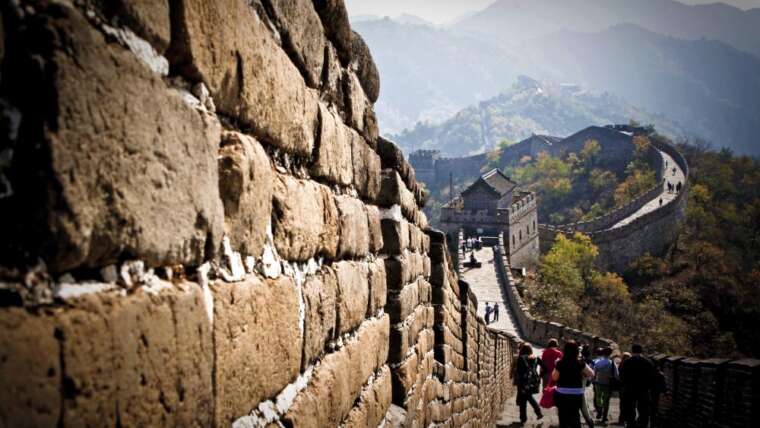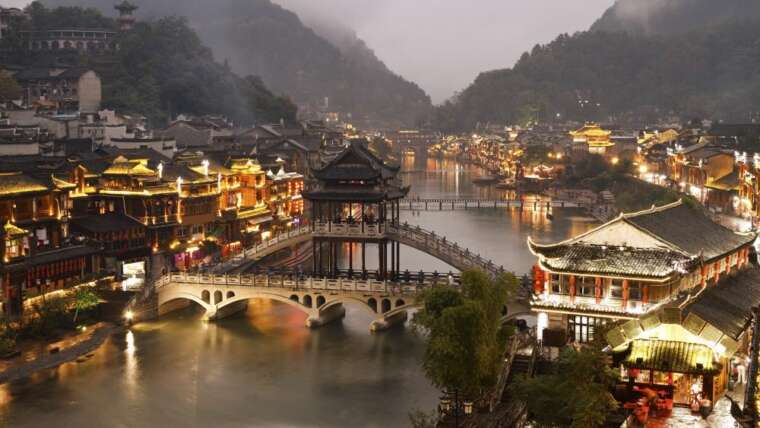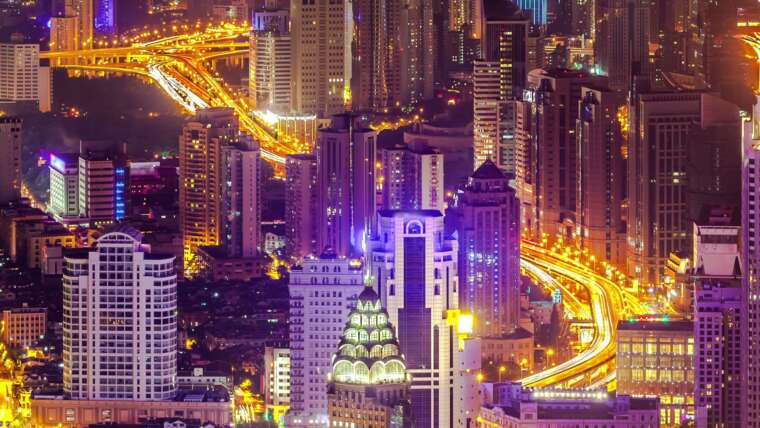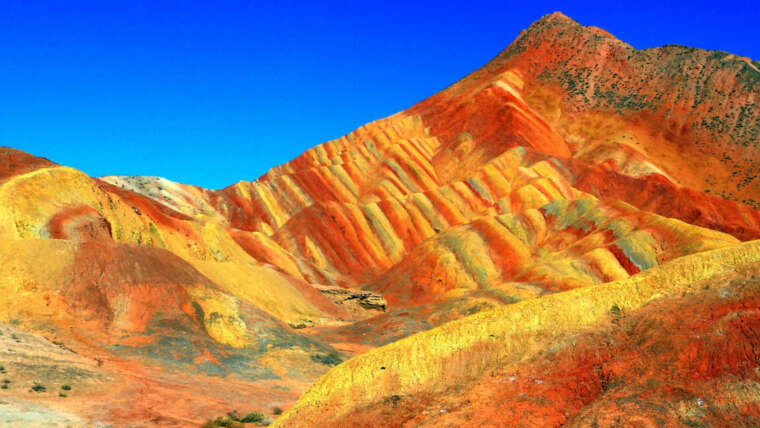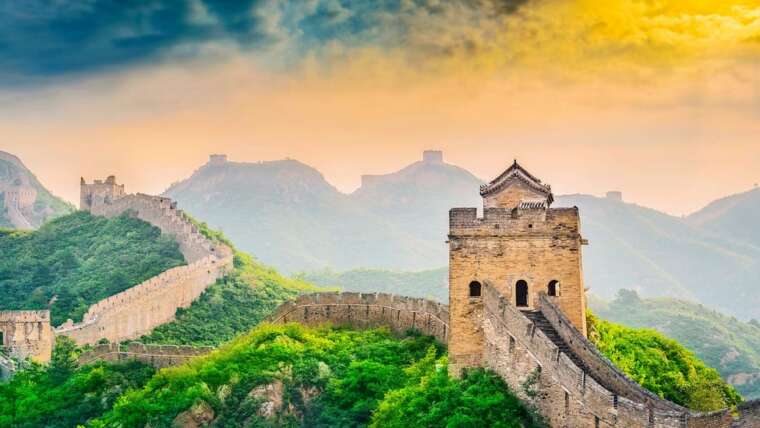China - Like Never Before!
We are an award winning tour and travel company specialising in adventure and unique cultural tailor made holidays along with small group tours to some of the most interesting places in China and its neighbouring countries. With experience of over 30 years, it is now one of the largest service provider for adventure tours in China.
Our world is full of adventure. Hidden landscapes to explore, unique cultures to uncover and unusual cuisines to taste and share. But it is not just the adventures that inspire us to travel. Our best memories come from real experiences. That the things we do and the places we go make us feel more fulfilled and alive.
We know a real experience can take you beyond your dreams, we know a real experience can set your heart on fire annd we know a real experience can make you feel like you never want to leave. We are experts at showing you the real China. We seek out the forgotten and unfamiliar. So every step of your journey is fresh and exciting.
– With us you’ll feel like you’ve travelled the unknown
– With us you’ll feel like you’ve found the world full of surprises
– With us you’ll feel like the places you’ve been will stay with you forever
A real adventure is a great adventure, so how will you discover the real China?
History of China
The cradles of Chinese civilization is the well-known Yellow River as well as Yangtze River. The footprint of Chinese people along these two rivers shows the valuable history of this aged country. Thousands of years ago, countries are built and people take up agricultural production, and begin to receive education. Since then, China has an opening atmosphere for philosophy, and creates a thriving culture, and people creates lots of legends and tales.
There are several popular legends about Pangu, Nv wa, Houyi, which are about the creation of the world. Pangu is the earliest ancestor of Chinese people, taken as the creator of the universe, and a succession of legendary sage-emperors and culture heroes (among them are Huang Di, Yao, and Shun) who teaches the ancient Chinese to communicate and to find sustenance, clothing, and shelter. Nv wa is the creator of human, and Houyi shoots eight sun and leaves one sun in the world. Lots of legendary people are created and those legends about them are a culture to China.
The history of China has been divided into several phases according political system: primitive society, feudal society, and modern society
According to historic records, in this phase, countries has been built, and systems has been made in every fields like politics, agriculture production, and education. Still in this phase, China is not a united countriy, but it is governed by several small countries. Most countries are mainly founded in the center and north of China, centering Hunan province. Those countries build the foundation of China in fields like agriculture, and political reform. In such a phase with over two thousand years, there are three important dynasties and two eventful periods.
Xia: Xia Dynasty is the first prehistoric dynasty applying hereditary system, existed in about the twenty-first century B.C to the sixteenth century B.C. Information about this dynasty comes from historic records, tales, and unearthed items. Since it is in the most early period, tales and myths are mixed with history, and it is difficult to separate myths from reality in regard to the Xia. Xia period marks an evolutionary stage between the late neolithic cultures and the typical Chinese urban civilization of the Shang dynasty. In this dynasty, people use stone tools to take up production, and also create written characters, which is one of the most important things to China development.
Shang: Shang Dynasty is the dynasty after the downfall of Xia Dynasty, and in the period from about 1600 B.C . to 1046 B.C. It is built by Shangtang who overthrows the ruling of Xia Dynasty. In this dynasty, written letters evolve into “jiaguwen” and “jinwen”, which are used to record its history. “Jiaguwen” is inscriptions on bones and tortoise shells. Moreover, the craft of making bronze wares is more mature than that in the Xia Dynasty. Those unearthed bronze wares have beautiful decorations, and the most well known one is simuwu ding, which is a representative work of bronze ware culture. Except bronze ware, people makes other vessels for daily life, like pottery and drinking vessel.
Zhou: The Zhou Dynasty is in the period from 1046 B.C. TO 256 B.C., and divided into two times, the Western Zhou Dynasty and the Easter Zhou Dynasty. In this dynasty, the society has developed to a higher place.
The Spring and Autumn Period is from 770 B.C. to 476 B.C. and the Warring States Period is from 453 B.C to 221 B.C. This two periods are overlapped with the Zhou Dynasty, and under the ruling of the Zhou Dynasty, there are small countries ruled by kings under the control of the Emperor of the Zhou Dynasty. Because of this, an opening atmosphere for culture and politics development is formed, and enormous philosophy and wisdom are created, and over ten schools of philosophy are founded by philosophers and thinkers. Great philosophers like Confucius and Laozi have created their own philosophy. The great military book, the Art of War is created in this period, and the wars between subordinated countries in this two periods may be one of the factors in its creation. Other famous works are like The Analects of Confucius, and the Classic of Poetry.
The feudal society phase is from 221 B.C. to 1912 A.D., and dozens of dynasties are found, and it shapes China’s economy, politics, education, etc. In this phase, China has its heyday at the Tang Dynasty and Yuan Dynasty, and has its tough times in the end of the Qing Dynasty.
Qin: Qin Dynasty is a landmark in China history, and it is the first feudal dynasty. It unites the whole country from the south, Guangxi and Guangdong to the north for the first time, which has great meanings in politics, and implement unified systems. It applies a series of systems in agriculture, military, economic, politics and culture, and improves people’s living standard and the civilization level of the whole country. In this dynasty, people have a unified written style, xiaozhuan or seal script, a unified measure system in weight and length.
Han: With the famous emperor Liu Bang as its founder by in 206 B.C., the Han Dynasty is the first dynasty to embrace the philosophy of Confucianism, which becomes the ideological underpinning of all regimes until the end of imperial China.
Three Kingdoms Period: This is a period of civil wars. Three kingdoms are Wei, Shu, Wu which have overlapping reigns during the period from 220 A.D. -280 A.D.). Although this confrontation of this three kingdoms ends with the foundation of a new dynasty Jin.
Sui: The Sui Dynasty( 581 A.D. to 618 A.D.)unites China together again and sets up many institutions that are adopted by its successors, and also formulates the imperial examination system used for over one thousand years. The Grand Canal from Beijing to Hangzhou is built at this dynasty, which is a great water project, and has significances in military, economics and agriculture.
Tang: The Tang Dynasty ( 618 A.D. to 907 A.D.) is the most prosperous period and the culture in this time has a significant influence to the modern China. Buddhism becomes the predominant religion and is adopted by the imperial family and believed by many of the common people. The trade in Tang Dynasty helps this ancient country develop into a necessary country not only in the Asia but also in the world. The ancient city Xi’an has many tour spots telling glories and stories about this dynasty.
Song: In the Song Dynasty( 907 A.D. to 1279 A.D.), Kaifeng becomes the capital and the center of the country. The economy in this time still keep prosperous since the Tang Dynasty. In this dynasty, copper cash is adopted, and it is easy to carry. Marine trading is in prosperity, and it has trading business with decades of countries and set up many business ports in the South China.
Yuan: The Yuan Dynasty( 1271 A.D. to 1368 A.D.) is founded by a Mongolian Genghis Khan, the famous Emperor not only in China, but also all over the world. It is also the first dynasty created by the Chinese ethnic groups. In this dynasty, the territory of China is in a great expansion, but its ruling makes many conflicts to ethnic groups.
Ming: Throughout the Yuan Dynasty, which lasts less than a century, there is a relatively strong sentiment among the populace against the Mongol rule. The frequent natural disasters since the 1340s finally accelerate peasant revolts. The Yuan Dynasty is eventually overthrown by the Ming Dynasty( 1368 A.D. to 1644 A.D.) in 1368. The first Emperor of the Ming Dynasty is Zhu Yuanzhan, who reforms the politic system for the benefit of the royal family. His son, Zhu Di moved the capital from Nanjing to Beijing, and built the Forbidden city.
Qing: the Qing Dynasty( 1644 A.D. to 1912 A.D.) is the last Chinese dynasty in history. It is also a mark of the beginning of modern China. The Qing Dynasty is established by the Manchu People (Nuzhen People). Within about 268 years, it is ruled by 11 emperors including Kangxi, Yongzheng and Qianlong who are very famous for their political policies. In the late period of this dynasty, China is invaded by foreign countries, and has a very tough time.
Modern Society Phase
Republic of China: Since the Opium War in 1840, China experiences a history tougher than any time in the past. During these days, the famous leader, Sun Yet-sen strands on the historic stage. Other historical figures such as Yuan Shikai and Chiang Kai Shek also influence the Republic of China deeply. Sun Yet-sen leads people to overthrow the ruling of the Qing Dynasty, and establishes the Republic of China in 1912. But it doesn’t end the oppression from foreign countries, and China is still in a war time and people live in a misery.
People’s Republic of China: Mao Zedong leads Chinese people to overthrow the Republic of China, and founds the People’s Republic of China in 1949, and sets up a series of system in politics, economics, etc., which builds a good foundation for the modern China. Because of its great influence in the Second World War, China becomes a permanent member of the United Nations security council. Since its establishment, China has put great efforts in developing its economic, and opens to the world in 1978, and enters into WTO in 2001.
Nowadays: With the hard work of over one billion of Chinese people, China has grown into a strong countries in economic, social, industrial, technology as well as agricultural aspects. China is the second largest economy, and has great achievements in aerospace industry.
Art & Culture of China
Chinese art, the painting, calligraphy, architecture, pottery, sculpture, bronzes, jade carving, and other fine or decorative art forms produced in China over the centuries.
One of the outstanding characteristics of Chinese art is the extent to which it reflects the class structure that has existed at different times in Chinese history. Up to the Warring States period (475–221 BCE), the arts were produced by anonymous craftsmen for the royal and feudal courts. It is believed that during the Shang and early Zhou periods the production of ritual bronzes was exclusively regulated under the authority of the court, which could grant or withhold authorization for production by regional workshops among the various states or others who paid fealty to the court. Under the careful regulation of court patrons in the Shang and Zhou periods, design features were shared among specialists working in the various media and were remarkably uniform from bronzes to lacquerwares to textiles.
During the Warring States period and the Han dynasty (206 BCE–220 CE), the growth of a landowning and merchant class brought new patrons. After the Han there began to emerge the concept of cultural practice as the product of the leisure of the educated gentry, many of whom were amateur practitioners of the arts of poetry, music, calligraphy, and, eventually, painting. At this time a distinction began to arise between the lower-class professional and the elite amateur artist; this distinction would have a great influence on the character of Chinese art in later times. Gradually one tradition became identified with the artists and craftsmen who worked for the court or sold their work for profit.
The scholarly amateurs looked upon such people with some contempt, and the visual arts of the literati became a separate tradition that was increasingly refined and rarefied to the point that, from the Song dynasty (960–1279) onward, an assumed awkwardness (zhuo) or understatement (pingdan) in technique was admired as a mark of the amateur and gentleman. As a medium of highly individual expression, painting and calligraphy also became important media of exchange in a social economy where the giving of gifts was central to the building of an interpersonal network. Like skill in letters, poetry, or music, skill and expressive quality in the practice of calligraphy and painting helped establish one’s status in a society of learned individuals.
One effect of the revolutions of the 20th century was the breaking down of the class barriers between amateur and professional. During the Cultural Revolution of 1966–76, literati art and artists were denigrated and an emphasis was placed on anonymous, proletarian-made art like that of the Tang dynasty (618–907) and earlier.
Culture
Just as Washington Irving once wrote, ‘…had I been merely a lover of fine scenery, I should have felt little desire to seek elsewhere its gratification, for on no country have the charms of nature been more prodigally lavished. … but Europe held forth the charms of storied and poetical association. Europe was rich in the accumulated treasure of age. Her very ruins told the history of times gone by, and every moldering stone was a chronicle.’
Tourism is always closely related to culture. Cultural tourism becomes a new landmark in the tourist enterprise. For a tourist guide, it is a easy job to introduce or describe the natural scenery to the visitors, but it is not that easy for them to explain the culture. Hence, visitors have to study the culture thing themselves in order to gain an impressive trip.
China is a large country with time-honored history. From the ancient times, the ancestors of Chinese laboured, lived, and multiplied on this vast land and have created splendid culture. As one of the four cradles of world’s earliest civilizations, it has a recorded history of nearly 4,000 years. Throughout the history of Chinese civilization, its agriculture and handicrafts have been renowned for their high level of sophistication. During these 4,000 years, China has nurtured many great thinkers, inventors, statesmen, strategists, men of letters and artists, yielding a rich cultural heritage and fine cultural traditions.
People of China
China has a huge population of over one billion, and it supports 21% of the world’s population with 9% of the world’s cultivable land. With a territory of about 9,634,057 square kilometers, Chinese people scatter and live every inches of this land. In China, an idiom says although Chinese people may eat the same kind of rice, they can grow up into different kinds of people finally. Due to geographic limitation and other reasons, China is inhabited with decades of nationalities.
Ethnic Groups
Usually, we say that China has 56 ethnic groups, but in fact, China has more ethnic groups. 56 ethnic groups are identified and confirmed by the central government, and there are over 730 thousand of people whose ethnic status haven’t been identified and confirmed. The 56 ethnic groups have a comparably big population, some ethnic groups not in the 56 ethnic groups have a very small population. In the 56 ethnic groups, Han nationality is the biggest ethnic group, and other ethnic groups are also called ethnic minorities. Ethnic groups do not live in only one place, and they are in all over the China. Thousands of years ago, people move from one place to another because of war, disasters like drought and flood, or others. Since the opening to the world, and China completely dedicates itself to develop economy, the mobility of population has accelerated. Now, almost in every city, there are various ethnic groups living together. But still there are some regions where one nationality in compact communities, like the Zhuang in Guangxi, the Tibetan in Tibet, the Ulghur in Xinjiang, the Mongolian in Inner Mongolia, and the Hui in Ningxia.
Of the people enumerated in the 31 provinces, autonomous regions and municipalities and servicemen of the mainland of China, 1,159.40 millions of people or 91.59 percent are of Han nationality, and 106.43 millions of people or 8.41 percent are of various ethnic minorities. Among all ethnic minorities, there are 18 ethnic groups with a population over one million respectively, and they are the Mongol, Hui, Tibetan, Ulghur, Miao, Zhuang, Dong, Yao, Bai, ect. The Zhuang nationality is the biggest ethnic minority with a population over 16 million. Some ethnic minorities have a population less than ten thousand.
Contemporay Generations’ Life Pattern in China
People in their 70-80s
Enjoy respects in a very big family. This generation was mainly born in the Mao’s time, they may have several siblings and several daughters and sons. During holiday time, their daughters and sons would come back home and stay with them to celebrate the holiday together in traditional ways.
People in their 50-70s
Enjoy their retire life. Their retire life is supported by the state welfare system and the gain pensions monthly for their daily expense. In the case that people are covered by the welfare system, their later life is supported by their families or by themselves. For most people, their savings are rarely kept to themselves and used to travel the world, but contribute to the purchase of their children’ s new house. In recent years, there is a growing number of people in 50-70s who are inclined to go to nursing homes and spend their later life there.
People in their 30-50s
Major working force in China. They work hard and support their family, spending money mainly in children’s education, and car and house purchasing and planning to save enough money to have a higher quality of retire life. They have high requirements about their life and consider social status, cars, houses, wealthy and luxury holiday aboard as symbols for having a good life.
People in their 20-30s
Single child generation. Creative, vigorous and dynamic. They value an interesting and fantastic life, like to travel and make friends with others. For job’s need, they are armed themselves knowledge and various skills.
People in their 0-20s
They are in a period of receiving education in schools and have fun with their families and friends. They may have another sibling due to the newly released two-child policy.
Explore & Discover China
FESTIVALS & ACTIVITIES
See all that is China. Experience the festivities and activities from the Ice & Snow Sculpture Festival to the Festival of Lanterns. For the avid auto fans, there are the Beijing and Shanghai International Automobile Exhibition. Interest in motion pictures? See the Shanghai International Film Festival.
DISCOVER CULTURE
The glorious history of Chinese literature is reflected in the Book of Songs, Songs of Chu, Poetry of Han Dynasty, Book of Jin, Poetry of Tang Dynasty, Song Poems, Verse of Yuan, traditional Chinese novels with a couplet title of Ming and Qing dynasty, and essays of the Republic of China since the pre-Qin period. China has colorful folk cultures. Traditional artistic forms include poetry, traditional Chinese operas, calligraphies, and traditional Chinese paintings.
ENTERTAINMENT
Residential areas in China are equipped with fitness clubs, bowling rooms, and swimming pools. Hotels often have bowling rooms, billiard rooms, gymnasiums, closed-circuit television and satellite TV. Singing and dancing halls, nightclubs, bars, and KTVs are often open all night.
FOOD
Chinese cuisine has developed for several thousand years, composed by royal palace cuisine in various dynasties, feudal official cuisine and different local cuisines. Famous styles of cuisines include: Shandong cuisine, Sichuan cuisine, Cantonese cuisine, Fujian cuisine, Jiangsu Cuisine, Zhejiang Cuisine, Hunan Cuisine, and Anhui Cuisine. Ingredients in Chinese cuisine are mostly made into the small size suitable for eating. Chopsticks are used for solid food.




